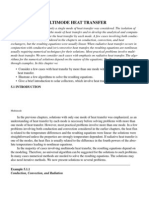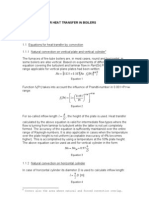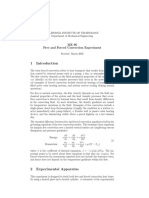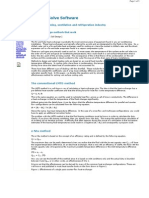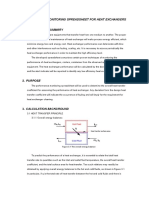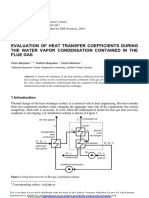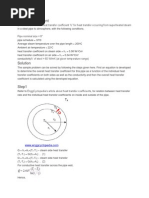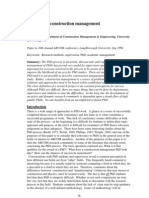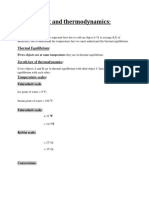Notes From Net
Notes From Net
Uploaded by
Palanisamy RajaCopyright:
Available Formats
Notes From Net
Notes From Net
Uploaded by
Palanisamy RajaOriginal Description:
Original Title
Copyright
Available Formats
Share this document
Did you find this document useful?
Is this content inappropriate?
Copyright:
Available Formats
Notes From Net
Notes From Net
Uploaded by
Palanisamy RajaCopyright:
Available Formats
CHAPTER 5
Principles of Convection
of Pr 2/ 3 for the flat-plate problem and, as it turns out, this dependence works fairly well for
rurbulent tube flow. Equations (5-114) and (5-116) may be modified by this factor to yield
St Pr 2/ 3 =
[5-114a]
[5-116a]
As we shall see in Chapter 6, Equation (5-116a) predicts heat-transfer coefficients that
are somewhat higher than those observed in experiments. The purpose of the discussion at
this point has been to show that one may arrive at a relation for turbulent heat transfer in a
fairly simple analytical fashion. As we have indicated earlier, a rigorous development of the
Reynolds analogy between heat transfer and fluid friction involves considerations beyond
the scope of our discussion, and the simple path of reasoning chosen here is offered for the
purpose of indicating the general nature of the physical processes.
For calculation purposes, a more correct relation to use for turbulent flow in a smooth
mbe is Equation (6-4a), which we list here for comparison:
NUd
= 0.023 � � � � � PrO A
[6-4a]
All properties in Equation (6-4a) are evaluated at the bulk temperature.
5-12 I HEAT TRANSFER IN HIGH-SPEED FLOW
Our previous analysis of � � � � � � � � � � � � � � heat transfer (Section 5-6) neglected the effects
of viscous dissipation within the boundary layer. When the free-stream velocity is very
high, as in high-speed aircraft, these dissipation effects must be considered. We begin our
analysis by considering the adiabatic case, i.e., a perfectly insulated wall. In this case the wall
temperature may be considerably higher than the free-stream temperature even though no
heat transfer takes place. This high temperature results from two situations: (1) the increase
in temperature of the fluid as it is brought to rest at the plate surface while the kinetic energy
of the flow is converted to internal thermal energy, and (2) the heating effect due to viscous
dissipation. Consider the first situation. The kinetic energy of the gas is converted to thermal
energy as the gas is brought to rest, and this process is described by the steady-flow energy
equation for an adiabatic process:
..1 2
+u oo
2g c
to = too
[5117]
where io is the stagnation enthalpy of the gas. This equation may be written in terms of
temperature as
1 2
cp(To - Too) = - u oo
2g c
where To is the stagnation temperature and Too is the static free-stream temperature.
Expressed in terms of the free-stream Mach number, it is
Tlo
y-l
- = 1 + __ M 2
Too
2
00
where Moo is the Mach number, defined as Moo
which for an ideal gas may be calculated with
= uoo/a,
a = JygcRT
where R is the gas constant for the particular gas.
[5-118]
and a is the acoustic velocity,
[5-119]
259
260
5-12
Heat Transfer in High-Speed Flow
In the actual case of a boundary-layer flow problem, the fluid is not brought to rest
reversibly because the viscous action is basically an irreversible process in a thermodynamic
sense. In addition, not all the free-stream kinetic energy is converted to thermal energypart is lost as heat, and part is dissipated in the form of viscous work. To take into account
the irreversibilities in the boundary-layer flow system, a recovery factor is defined by
Taw - Too
r=---To - Too
[5-120]
where Taw is the actual adiabatic wall temperature and Too is the static temperature of
the free stream. The recovery factor may be determined experimentally, or, for some flow
systems, analytical calculations may be made.
The boundary-layer energy equation
aT
u ax
aT
+ v ay
2
a T
= a ay 2
f1-
+ pCp
(au)2
ay
has been solved for the high-speed-flow situation, taking into account the viscous-heating
term. Although the complete solution is somewhat tedious, the final results are remarkably
simple. For our purposes we present only the results and indicate how they may be applied.
The reader is referred to Appendix B for an exact solution to Equation (5-22). An excellent
synopsis of the high-speed heat-transfer problem is given in a report by Eckert [4]. Some
typical boundary-layer temperature profiles for an adiabatic wall in high-speed flow are
given in Figure B-3.
The essential result of the high-speed heat-transfer analysis is that heat-transfer rates
may generally be calculated with the same relations used for low-speed incompressible
flow when the average heat-transfer coefficient is redefined with the relation
[5-121]
Notice that the difference between the adiabatic wall temperature and the actual wall temperature is used in the definition so that the expression will yield a value of zero heat flow
when the wall is at the adiabatic wall temperature. For gases with Prandtl numbers near
unity, the following relations for the recovery factor have been derived:
Laminar flow:
r = Pr l / 2
[5-122]
Turbulent flow:
r =Pr l / 3
[5-123]
These recovery factors may be used in conjunction with Equation (5-120) to obtain the
adiabatic wall temperature.
In high-velocity boundary layers substantial temperature gradients may occur, and
there will be correspondingly large property variations across the boundary layer. The
constant-property heat-transfer equations may still be used if the properties are introduced
at a reference temperature T* as recommended by Eckert:
T*
= Too + 0.50(Tw -
Too)
+ 0.22(Taw -
Too)
[5-124]
The analogy between heat transfer and fluid friction [Equation (5-56)] may also be used
when the friction coefficient is known. Summarizing the relations used for high-speed heattransfer calculations:
Laminar boundary layer (Rex < 5 x 105 ):
St; Pr*2/3
= 0.332 Re;-1/2
[5-125]
C HAP T E R 5
Turbulent boundary layer (5 x 105 < Rex < 10 7 )
St*x Pr*2/3
Principles of Convection
= 0 . 0296 Re*-1/5
x
[5-126]
Turbulent boundary layer (10 7 < Rex < 109 ):
St: Pr*2/3
= 0.185 (log Re:) -2.584
[5-127]
The superscript * in the above equations indicates that the properties are evaluated at the
ference temperature given by Equation (5-124).
To obtain an average heat-transfer coefficient, the above expressions must be inte_ ated over the length of the plate. If the Reynolds number falls in a range such that
Equation (5-127) must be used, the integration cannot be expressed in closed form, and a
numerical integration must be performed. Care must be taken in performing the integration
for the high-speed heat-transfer problem since the reference temperature is different for the
laminar and turbulent portions of the boundary layer. This results from the different value
of the recovery factor used for laminar and turbulent flow as given by Equations (5-122)
and (5-123).
When very high flow velocities are encountered, the adiabatic wall temperature may
come so high that dissociation of the gas will take place and there will be a very wide
'ariation of the properties in the boundary layer. Eckert [4] recommends that these probems be treated on the basis of a heat-transfer coefficient defined in terms of enthalpy
difference:
[5-128]
The enthalpy recovery factor is then defined as
iaw
ri=.
ioo
[5-129]
10 -100
'here i aw is the enthalpy at the adiabatic wall conditions. The same relations as before
are used to calculate the recovery factor and heat-transfer except that all properties are
evaluated at a reference enthalpy i* given by
i* = i oo
+ 0.5(i w -
i oo )
+ 0.22(iaw -
i oo )
[5-130]
The Stanton number is redefined as
[5-131]
This Stanton number is then used in Equation (5-125), (5-126), or (5-127) to calculate the
heat-transfer coefficient. When calculating the enthalpies for use in the above relations,
the total enthalpy must be used; that is chemical energy of dissociation as well as internal
thermal energy must be included. The reference-enthalpy method has proved successful for
alculating high-speed heat-transfer with an accuracy of better than 10 percent.
High-Speed Heat Transfer for a Flat Plate
A flat plate 70 cm long and 1.0 m wide is placed in a wind tunnel where the flow conditions
atm, and T = -40C. How much cooling must be used to maintain the plate
are M = 3, p =
temperature at 35C?
-io
261
262
5-12
Heat Transfer in High-Speed Flow
Solution
We must consider the laminar and turbulent portions of the boundary layer separately because the
recovery factors, and hence the adiabatic wall temperatures, used to establish the heat flow will
be different for each flow regime. It turns out that the difference is rather small in this problem,
but we shall follow a procedure that would be used if the difference were appreciable, so that the
general method of solution may be indicated. The free-stream acoustic velocity is calculated from
a = )ygcRT00 = [(1.4)(1.0)(287)(233)] 1/2 = 306 m/s
[1003 ft/s]
so that the free-stream velocity is
Uoo
= (3)(306) =918 m/s
[3012 fils]
The maximum Reynolds number is estimated by making a computation based on properties evaluated at free-stream conditions:
P
00
(1.0132 x 10 5)(to)
3
= 0.0758 kg/m
(287) (233)
3
3
[4.73 x 10- Ibm/fi]
= 1.434 x 10- 5 kg/m s [0.0347 Ibm/h ft]
(0.0758)(918)(0.70)
6
ReL 00 =
5
= 3.395 x 10
,
1.434 x 10Moo
Thus we conclude that both laminar and turbulent-boundary-layer heat transfer must be considered.
We first determine the reference temperatures for the two regimes and then evaluate properties at
these temperatures.
Laminar portion
TO = Too (1
+ Y�
1�
) = (233)[1
+ (0.2)(3)2] = 652 K
Assuming a Prandtl number of about 0.7, we have
r=Pr l / 2 = (0.7)1/2 =0.837
r=
Taw - Too
To - Too
Taw - 233
652 - 233
and Taw = 584 K = 311 c [592P]. Then the reference temperature from Equation (5-123) is
T* = 233 + (0.5)(308 - 233) + (0.22)(584 - 233) = 347.8 K
Checking the PrandtJ number at this temperature, we have
Pr* =0.697
so that the calculation is valid. If there were an appreciable difference between the value of Pr*
and the value used to determine the recovery factor, the calculation would have to be repeated
until agreement was reached.
The other properties to be used in the laminar heat-transfer analysis are
P* =
(1.0132 x 105)(1/20)
3
=0.0508 kg/m
(287)(347.8)
M* = 2.07 x 10- 5 kg/m s
k* = 0.03 W/m c
c p * = 1.009 kJ /kg . c
[0.0173 Btu/h fi OF]
C HAP T E R 5
Principles of Convection
Turbulent portion
Assuming Pr = 0.7 gives
r = Pr 1/ 3 = 0.888 = Taw - Too = Taw - 233
TO - Too
652 - 233
Taw = 605 K = 332C
T* = 233 + (0.5)(308 - 233) + (0.22)(605 - 233) = 352.3 K
Pr*=0.695
The agreement between Pr* and the assumed value is sufficiently close. The other properties to
be used in the turbulent heat-transfer analysis are
5
3
(1.0132 x 10 )(1/20) 0050
=.lkg/m
(287) (352.3)
fL * = 2.09 x 10- 5 kg/m . s
P* =
k* =0.0302 W/m c
cp* = 1.009 kJ/kg c
Laminar heat transfer
We assume
Re* ' t-- 5 x 105 -_ p*uooxc
cn
fL*
Xc
(5 x 105)(2.07 x 10-5)
=
(0.0508)(918)
=0.222 m
Nu* =
� k*� �
= 0.664 (Re* . ) 1/2 Pr*1/3
ent
= (0.664)(5 x 105) 1/2(0.697) 1/3 = 416.3
h = (416.3)(0.03) = 56.25 W/m 2 .oc [9.91 Btu/h. ft2 . OF]
0.222
This is the average heat-transfer coefficient for the laminar portion of the boundary layer, and the
heat transfer is calculated from
q=hA(Tw - Taw)
= (56.26)(0.222)(308 - 584)
=-3445W
[-11,750 Btu/h]
so that 3445 W of cooling is required in the laminar region of the plate per meter of depth in the
z direction.
Thrbulent heat transfer
To determine the turbulent heat transfer we must obtain an expression for the local heat-transfer
coefficient from
St; Pr*2/3 = 0.0296 Re;-1/5
and then integrate from
= 0.222 m to x = 0.7 m to determine the total heat transfer:
h x =Pr*-2f3 p *uooc p (0.0296) (
Inserting the numerical values for the properties gives
hx
= 94.34x- I/ 5
p*u X)-1/5
fL':
263
264
Review Questions
The average heat-transfer coefficient in the turbulent region is determined from
Using this value we may calculate the heat transfer in the turbulent region of the flat plate:
q = hA(Tw - Taw)
= (111.46)(0.7 - 0.222)(308 - 605)
= -15,823 W [-54,006 Btu/h]
The total amount of cooling required is the sum of the heat transfers for the laminar and turbulent
portions:
Total cooling = 3445 + 15,823 = 19,268 W [65,761 Btu/h]
These calculations assume unit depth of 1 m in the z direction.
5-13 I SUMMARY
Most of this chapter has been concerned with flow over flat plates and the associated heat
transfer. For convenience of the reader we have summarized the heat-transfer, boundarylayer thickness, and friction-coefficient equations in Table 5-2 along with the restrictions
that apply. Our presentation of convection heat transfer is incomplete at this time and will be
developed further in Chapters 6 and 7. Even so, we begin to see the structure of a procedure
for solution of convection problems:
1. Establish the geometry of the situation; for now we are mainly restricted to flow over
flat plates.
2. Determine the fluid involved and evaluate the fluid properties. This will usually be at
the film temperature.
3. Establish the boundary conditions (i.e., constant temperature or constant heat flux).
4. Establish the flow regime as determined by the Reynolds number.
5. Select the appropriate equation, taking into account the flow regime and any fluid property restrictions which may apply.
6. Calculate the value(s) of the convection heat-transfer coefficient and/or heat transfer.
At the conclusion of Chapter 7 we shall give a general procedure for all convection problems
and the information contained in Table 5-2 will comprise one ingredient in the overall recipe.
The interested reader may wish to consult Section 7-14 and Figure 7-15 for a preview of
this information and some perspective of the way the material in the present chapter fits in.
REVIEW QUESTIONS
1.
2.
3.
4.
What is meant by a hydrodynamic boundary level?
Define the Reynolds number. Why is it important?
What is the physical mechanism of viscous action?
Distinguish between laminar and turbulent flow in a physical sense.
You might also like
- Industrial Steam Systems Fundamentals and Best Design Practices PDFDocument236 pagesIndustrial Steam Systems Fundamentals and Best Design Practices PDFazkona100% (4)
- Multi ModeDocument73 pagesMulti ModeShalinee KavadiyaNo ratings yet
- Guidelines For Ethylene Quench Tower Rev IntroDocument12 pagesGuidelines For Ethylene Quench Tower Rev IntroGuntoro AliNo ratings yet
- Reactor Design ProjectDocument13 pagesReactor Design ProjectSusi UmifarahNo ratings yet
- An Introduction To Convective Heat Transfer AnalysisDocument24 pagesAn Introduction To Convective Heat Transfer AnalysishamidNo ratings yet
- A Temperature Wall Function Formulation ForDocument13 pagesA Temperature Wall Function Formulation Forbmw530liNo ratings yet
- Building Science Makes A Case For Two LayersDocument6 pagesBuilding Science Makes A Case For Two LayersPalanisamy RajaNo ratings yet
- 5-12 High Speed Flow Heat TransDocument6 pages5-12 High Speed Flow Heat TransNaren BharatwajNo ratings yet
- ONAN Power Transformer Heat Transfer ModelingDocument4 pagesONAN Power Transformer Heat Transfer ModelingSEP-PublisherNo ratings yet
- Estimation of Over-All Heat TransferDocument10 pagesEstimation of Over-All Heat TransferAllan Troy SalazarNo ratings yet
- Heat TransferDocument7 pagesHeat TransferEngr. AbdullahNo ratings yet
- Design of Heat ExchangersDocument20 pagesDesign of Heat ExchangersSudhir JadhavNo ratings yet
- As-74 3179 Understanding The Heat Transfer CoefficientDocument4 pagesAs-74 3179 Understanding The Heat Transfer CoefficientLaurence MalanumNo ratings yet
- TA125Document4 pagesTA125WaqasjamNo ratings yet
- Finite Element Analysis of Coupled Thermoelasticity PDFDocument8 pagesFinite Element Analysis of Coupled Thermoelasticity PDFCarlosNo ratings yet
- Ramjets: Thermal Management - An Integrated Engineering ApproachDocument22 pagesRamjets: Thermal Management - An Integrated Engineering ApproachvinayanandyadavNo ratings yet
- Equations For Heat Transfer in BoilersDocument9 pagesEquations For Heat Transfer in BoilersamitdharneNo ratings yet
- Relief PDFDocument0 pagesRelief PDFscribpenumakaNo ratings yet
- Study of Two-Dimensional Heat and Mass Transfer During PDFDocument11 pagesStudy of Two-Dimensional Heat and Mass Transfer During PDFali105No ratings yet
- Thermodynamics PoeDocument8 pagesThermodynamics Poeg0227518cNo ratings yet
- Convection 2003Document6 pagesConvection 2003najmadeenNo ratings yet
- Natural and Forced Convection ExperimentsDocument12 pagesNatural and Forced Convection ExperimentsOmar Yamil Sanchez Torres25% (4)
- Articulo Version FinalDocument12 pagesArticulo Version FinalDon GonzaloNo ratings yet
- Guidelines For Ethylene Quench Tower Rev 17Document17 pagesGuidelines For Ethylene Quench Tower Rev 17totongop0% (1)
- Coil DesignDocument5 pagesCoil DesigngaryckfanNo ratings yet
- Guidelines For Ethylene Quench Tower Rev IntroDocument13 pagesGuidelines For Ethylene Quench Tower Rev IntroMubarik AliNo ratings yet
- sm1 45Document2 pagessm1 45awoods12835No ratings yet
- Empirical Relations For Pipe and Tube FlowDocument11 pagesEmpirical Relations For Pipe and Tube FlowChemical EngineeringNo ratings yet
- Phase Change SimulationDocument106 pagesPhase Change SimulationAshish AgarwalNo ratings yet
- Combustion Design FundementalsDocument12 pagesCombustion Design FundementalsYunus EmreNo ratings yet
- Rase - Chemical Reactor Design - Vol 2-Case 101Document9 pagesRase - Chemical Reactor Design - Vol 2-Case 101Md.Faysal Ahamed Khan0% (1)
- Mathematical Modeling of The Evacated Solar CollectorDocument10 pagesMathematical Modeling of The Evacated Solar CollectorVedhas WalimbeNo ratings yet
- Low RSQ Value PaperDocument12 pagesLow RSQ Value PaperPranshu DixitNo ratings yet
- RefrigerationDocument163 pagesRefrigerationali105No ratings yet
- ME 320 Lab 4Document17 pagesME 320 Lab 4Ajay KrishNo ratings yet
- Air Cycle Refrigeration Systems (Indian Institute of Technology Kharagpur)Document15 pagesAir Cycle Refrigeration Systems (Indian Institute of Technology Kharagpur)emawz21No ratings yet
- Kabelac Solar EnergyDocument6 pagesKabelac Solar EnergyJulio CarvalhoNo ratings yet
- Heat Transfer and Heat - ExchangersDocument6 pagesHeat Transfer and Heat - ExchangersVinh Do ThanhNo ratings yet
- Value Diagrams and Exergy EfficienciesDocument13 pagesValue Diagrams and Exergy EfficienciesElzimar FreitasNo ratings yet
- HVAC Coil DesignDocument7 pagesHVAC Coil DesignAnonymous 73gEYyEtLNo ratings yet
- TGA BasicsDocument9 pagesTGA BasicsDibakarMondalNo ratings yet
- Boundary Conditions (Part u)Document12 pagesBoundary Conditions (Part u)Dikra BkNo ratings yet
- Heat ExchangersDocument6 pagesHeat ExchangersGerry LouNo ratings yet
- Report Performance of Heat ExchangerDocument27 pagesReport Performance of Heat ExchangerAnonymous ntK705Rt100% (2)
- A Theoretical Analysis and CFD Simulation On The Ceramic Monolith Heat ExchangerDocument12 pagesA Theoretical Analysis and CFD Simulation On The Ceramic Monolith Heat ExchangerMohamed AshrafNo ratings yet
- Introduction To Proportional, Integral Control: First Order SystemsDocument8 pagesIntroduction To Proportional, Integral Control: First Order SystemsulaganathanNo ratings yet
- Ammonia SynthesisDocument9 pagesAmmonia SynthesisMohammed Shafi AhmedNo ratings yet
- Teknik Reaksi KimiaDocument10 pagesTeknik Reaksi KimiaibnuxmubarokNo ratings yet
- Evaluation of Heat Transfer Coefficients During The Water Vapor Condensation Contained in The Flue GasDocument5 pagesEvaluation of Heat Transfer Coefficients During The Water Vapor Condensation Contained in The Flue GasreaktorenergiNo ratings yet
- Calculation of Overall Heat Transfer CoefficientDocument2 pagesCalculation of Overall Heat Transfer CoefficientSrihari Kodimela100% (1)
- Overall - Finned TubeDocument14 pagesOverall - Finned TubeSakthi VelNo ratings yet
- ME 315 - Heat Transfer Laboratory Experiment No. 8 Forced Convection From A Circular Cylinder Subjected To Cross FlowDocument11 pagesME 315 - Heat Transfer Laboratory Experiment No. 8 Forced Convection From A Circular Cylinder Subjected To Cross FlowSharath SharuNo ratings yet
- Guide - Sharing ACMV System - BasicsDocument135 pagesGuide - Sharing ACMV System - BasicsAmazing PaiNo ratings yet
- Entropy ChangeDocument13 pagesEntropy Changeنبيل محمد عيد ابوميراNo ratings yet
- A Modern Course in Statistical PhysicsFrom EverandA Modern Course in Statistical PhysicsRating: 3.5 out of 5 stars3.5/5 (2)
- 9 Am 9 Am: Confirmation of Delivery For Precast ComponentsDocument7 pages9 Am 9 Am: Confirmation of Delivery For Precast ComponentsPalanisamy RajaNo ratings yet
- Hospital SynopsisDocument1 pageHospital SynopsisPalanisamy RajaNo ratings yet
- 0.99% Effective Interest Per Month When You Apply.: Anz MoneylineDocument4 pages0.99% Effective Interest Per Month When You Apply.: Anz MoneylinePalanisamy RajaNo ratings yet
- ApplicationDocument2 pagesApplicationPalanisamy RajaNo ratings yet
- Aircraft Materials and Manufacturing ProcessDocument125 pagesAircraft Materials and Manufacturing ProcessPalanisamy RajaNo ratings yet
- Karpagam University: Be Degree ExaminationDocument2 pagesKarpagam University: Be Degree ExaminationPalanisamy RajaNo ratings yet
- ProjectDocument9 pagesProjectkavinkumarjackNo ratings yet
- List of Class I Contractors Registered With Public Works Department, PuducherryDocument3 pagesList of Class I Contractors Registered With Public Works Department, PuducherryPalanisamy RajaNo ratings yet
- Set-I BIMDocument1 pageSet-I BIMPalanisamy RajaNo ratings yet
- Planning For Pollution Free Construction Environment: S.Sathya Bama 13CMR014Document16 pagesPlanning For Pollution Free Construction Environment: S.Sathya Bama 13CMR014Palanisamy RajaNo ratings yet
- Project Control PDFDocument0 pagesProject Control PDFAgung A BaktiNo ratings yet
- Component Longevity in Terms of Operation Performance and Resistance To Deleterious ForcesDocument8 pagesComponent Longevity in Terms of Operation Performance and Resistance To Deleterious ForcesPalanisamy RajaNo ratings yet
- Kongu Engineering College,: Building Information Management Assignment - IDocument8 pagesKongu Engineering College,: Building Information Management Assignment - IPalanisamy RajaNo ratings yet
- The Repair of Earthquake Damaged Buildings: Robert D HANSON and Craig D ComartinDocument8 pagesThe Repair of Earthquake Damaged Buildings: Robert D HANSON and Craig D ComartinPalanisamy RajaNo ratings yet
- MCM AllDocument7 pagesMCM AllPalanisamy RajaNo ratings yet
- Several Social ThinkersDocument4 pagesSeveral Social ThinkersPalanisamy RajaNo ratings yet
- The PHD in Construction ManagementDocument11 pagesThe PHD in Construction ManagementPalanisamy RajaNo ratings yet
- Kongu Engineering College,: Modern Construction Materials - Assignment IDocument3 pagesKongu Engineering College,: Modern Construction Materials - Assignment IPalanisamy RajaNo ratings yet
- Introduction To Refrigeration and Air Conditioning Systems Theory and Applications (Allan T. Kirkpatrick) (Z-Library)Document165 pagesIntroduction To Refrigeration and Air Conditioning Systems Theory and Applications (Allan T. Kirkpatrick) (Z-Library)bernie oplasNo ratings yet
- Chemistry Lab 6Document5 pagesChemistry Lab 6KayenNo ratings yet
- PPC 2Document5 pagesPPC 2saptarshi pandeyNo ratings yet
- Enthalpy Changes: Youtube: Chemistry Bright Minds Visit Us On Blog: FacebookDocument12 pagesEnthalpy Changes: Youtube: Chemistry Bright Minds Visit Us On Blog: FacebookTokimemoto Lustre ReidNo ratings yet
- BTD Course FileDocument23 pagesBTD Course FilePrashant S HadagaliNo ratings yet
- NME3539 Lecture 1Document34 pagesNME3539 Lecture 1shadanarshad8728No ratings yet
- Enthalpy of Formation and Heating ValueDocument11 pagesEnthalpy of Formation and Heating ValueReydin CampoamorNo ratings yet
- Excel As Me P T CDocument6 pagesExcel As Me P T CNurdinHasanantoNo ratings yet
- Introduction To Aspen Plus - 2014Document214 pagesIntroduction To Aspen Plus - 2014Moy GonzálezNo ratings yet
- Material Stream: Sulfinol: ConditionsDocument2 pagesMaterial Stream: Sulfinol: ConditionsFmuharIrolNo ratings yet
- Thermophysical Properties of Fluids. II. Methane, Ethane, Propane, Lsobutane and N-ButaneDocument222 pagesThermophysical Properties of Fluids. II. Methane, Ethane, Propane, Lsobutane and N-ButaneCan YıldırımNo ratings yet
- Winsteam User'S ManualDocument22 pagesWinsteam User'S ManualAnkit Katiyar IshanNo ratings yet
- WTE Thesis DataRazoDocument14 pagesWTE Thesis DataRazoCHARLOTTE ANNE DATANo ratings yet
- 05 - To Compare The Enthalpies of Solution of A Salt in Its Anhydrous and Hydrated StatesDocument2 pages05 - To Compare The Enthalpies of Solution of A Salt in Its Anhydrous and Hydrated StatesAisha PetersNo ratings yet
- 2ND-TERM-S2-CHEMISTRYDocument46 pages2ND-TERM-S2-CHEMISTRYpalmer okiemuteNo ratings yet
- Learning Content: First Law of ThermodynamicsDocument7 pagesLearning Content: First Law of ThermodynamicsHENRICK IGLENo ratings yet
- Seatwork No 1Document2 pagesSeatwork No 1Cantera, Cris Bryan E.No ratings yet
- Electrolysis of WaterDocument5 pagesElectrolysis of WaterhimanshumalNo ratings yet
- Chapter 1 2 - DR JalalDocument67 pagesChapter 1 2 - DR JalalScorpion RoyalNo ratings yet
- Energy Changes in Chemical ReactionsDocument32 pagesEnergy Changes in Chemical ReactionsRon allen ConconNo ratings yet
- Thermodynamics NotesDocument14 pagesThermodynamics NotesFairy QueenNo ratings yet
- Neet - Chemistry Test - Thermodynamics (Obj) - 03.07.2023Document6 pagesNeet - Chemistry Test - Thermodynamics (Obj) - 03.07.2023rkshankarNo ratings yet
- Energetics QPDocument11 pagesEnergetics QPAlexia BaskaranNo ratings yet
- Calculate The Relieving Temperature & Latent Heat of Vaporization For Fire Case PSV Sizing by Shell DEP MethodDocument3 pagesCalculate The Relieving Temperature & Latent Heat of Vaporization For Fire Case PSV Sizing by Shell DEP Methodrohitkush83% (6)
- The Effects of Initial TemperatureDocument5 pagesThe Effects of Initial TemperatureErhan Sedat EnerNo ratings yet
- Lecture 4Document37 pagesLecture 4bettieboomNo ratings yet
- Dynamic Simulation and Optimal Matching of A Small-ScaleDocument7 pagesDynamic Simulation and Optimal Matching of A Small-ScaleEva ViskadourakiNo ratings yet
- Pipe 02: by TRC - Tiger's Review CenterDocument119 pagesPipe 02: by TRC - Tiger's Review Centerkristan7100% (1)
- Development of An Inexpensive Labview Based Refrigeration Cycle LaboratoryDocument5 pagesDevelopment of An Inexpensive Labview Based Refrigeration Cycle Laboratoryvinicius schwabNo ratings yet

